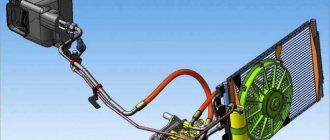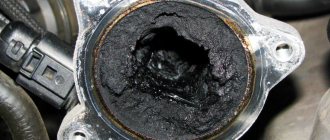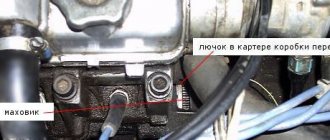Hello friends ! Let's discuss how to reduce Niva consumption using simple but effective actions. Despite the stable rise in fuel prices today, you can save by reducing fuel consumption. Here are some fuel-saving options that will increase your vehicle's mileage on a single tank. One of the best ways to save fuel is to buy gasoline in bulk. Wholesale is always cheaper, so you can buy fuel either in bulk or using discount coupons. This way you can save a small amount per 1 liter.
Niva 21214
The cost of maintaining a car is an important consideration before choosing one. Therefore, you need to know the fuel consumption on Niva 21214 per 100 km, which will make the task much easier. To do this, it is worth analyzing the main figures in this matter. At the beginning of the 20th century, the fuel system of the VAZ-2121 car was modified. As a result, the carburetor was replaced with an injection system, which reduced fuel consumption. This is how the Niva 21214 car appeared. This car model has an injection engine, which began to be produced in 1994. It has the following characteristics: a cast iron cylinder block that consists of four elements, with two valves for each. Engine, 1.7 liters, distributed fuel injection, combined lubrication system - under splash and pressure.
Engine Consumption (highway) Consumption (city) Consumption (combined cycle)
Gasoline 1.7 8.3 l/100 km 12.1 l/100 km 10 l/100 km
Fuel consumption
The fuel consumption of the Lada 21214 injector depends on the driver’s driving style and the time of year. If more fuel is used in winter, then this is normal, since due to the low temperature the engine warms up much longer. As is known from the data on the official website, the fuel consumption of the VAZ 21214 per 100 km in the summer is: In other words, on fuel consumption you can save a lot of money. Moreover, the Niva 21214 differs from its predecessors in lower fuel consumption due to its injection engine.
But there is also a second “side of the coin” - many drivers of such a car more than once on car enthusiast forums speak angrily about this model, and, accordingly, about the cost of gasoline for it.
Real numbers
In practice the situation is a little different. Some drivers consider fuel consumption to be more than acceptable - “fuel consumption on a VAZ 21214 injector is 8-8.5 liters per 100 kilometers, which I consider very economical.”
But the majority of car enthusiasts are still for the unprofitability of such a car model. This is, first of all, high gasoline consumption - on average 13-14 liters per 100 km on the highway in the summer - “gasoline consumption is quite high, because according to the passport it is 12 liters in the city, but in reality it is about 13 liters.”
In winter, the real gasoline consumption on the Niva 21214 per 100 km is 20-25 liters - “high costs, especially in severe frosts - up to 20 liters.”
So, we figured out the numbers. Now we need to find out why fuel consumption is such that some people have normal fuel consumption, and in some cases it is almost twice as high as normal.
Factors affecting gas mileage
If there is a problem with the amount of fuel consumed by the car, then you need to look for the source of the problem. Many engines with a fuel injection system lose efficiency if used incorrectly. This helps to increase the Niva 21214 gasoline consumption rate on the highway.
Basic moments
There are a number of other reasons for the increase in gasoline consumption by these cars:
Fuel consumption and temperature
A uniform and smooth driving style helps reduce gasoline consumption. It is not recommended to brake or accelerate the car sharply - the result will be the opposite. Some factors are present only in winter. Thanks to them, the average gasoline consumption on a VAZ 21214 can almost double. Increased fuel costs are determined by air temperature. The lower the thermometer shows, the higher the gasoline consumption. This is explained by the fact that the engine, seats, external windows and steering wheel, windshield and rear windows warm up. In addition to this, there are a number of other reasons:
How to save fuel
The reasons for increased gasoline consumption are known. But how to reduce gasoline costs on Niva and protect your budget:
Reducing consumption largely depends on the factors that increase it. And having studied them in detail, you can save on fuel at any time of the year. And fuel consumption on the injection Niva 21214 will be more than acceptable.
Good old SUV
The Niva 21214 car has proven to be a successful project, combining the cross-country capabilities of an all-terrain vehicle and the comfortable elements of a passenger car.
It is perfect for weekend trips out of town, weekend trips for fishing or hunting. And even the considerable costs of using a vase cannot upset lovers of this particular car model.
Warming up
So, we have a Niva-Chevrolet SUV. How to reduce fuel consumption? You can reduce the car's appetite while the engine is warming up. Modern oils work even at very low temperatures, which means the engine will start and warm up while driving. Now there is no great need for long warm-up.
For carburetor versions, the pump can be upgraded. There are two tubes. One is longer, the other is shorter. The longer tube can be bent slightly, and it should be directed into the first chamber. Two jets will hit one point, and this way you can reduce consumption. For those who have an accelerator with one tube, you can purchase a repair kit for 2108 carburetors here. In this case, the dynamic characteristics are not affected.
For injection versions, you can purchase an on-board computer. A calmer, non-aggressive driving, movement according to the tachometer, competent switching - this is what definitely allows you to reduce consumption.
The 1.8-liter Opel engine has the best performance. With a power of 125 horsepower per 100 kilometers, it consumes:
- 12.7 liters in the city;
- 8.4 liters on the highway;
- 10.3 liters in the combined cycle.
Engines with a volume of 1.7 liters produced by AvtoVAZ are distinguished by higher consumption and lower power. The 82-horsepower Euro-5 engine consumes:
- 14.1 liters in the city;
- 8.8 liters on the highway;
- 11.2 liters in the combined cycle.
The outdated 1.7 liter engine model without auxiliary devices, which meets the Euro-2 environmental standard, consumes slightly less - 10.8 l/100 km in the combined cycle.
Oddly enough, you have to pay for environmental friendliness with high fuel consumption. But AvtoVAZ no longer supplies Opel engines, which at the same time save the owner’s wallet.
Fuel consumption of Niva 2121: standards recommended by the manufacturer for the carburetor and injector
Greetings to the readers and subscribers of my blog! We have already talked about the Volvo S60, Ford Focus, VW Polo and the consumption of many other cars. Surely among you there are owners and drivers of the famous domestic SUV Niva. We promised to cover various and popular car brands. Considering the number of them on our roads, let’s take a closer look at what the fuel consumption of the Niva 2121 should be depending on the type of engine, and also whether it can be reduced.
How much do injection and carburetor engines consume?
Fuel consumption on a Niva with an injector engine will be slightly less than on a carburetor analogue. One of the most popular power units (or rather, almost the only one) is the 1.7 liter engine. On the highway it takes relatively little, for such a vehicle - only 9-10 liters. Despite the relatively small volume of the gas tank, it will be enough for long country trips up to 400 kilometers.
If you use primarily 5th gear, then fuel consumption can be reduced to an even smaller value - 8 liters. This is facilitated by an injection engine, which is more economical compared to a carburetor engine. However, urban driving mode will be wasteful for the Niva owner, since here you can often spend 13 or 14 liters “per hundred”. And this is still in the warm season, because when driving it in winter, be prepared to increase consumption by another 2-3 liters. This is all due to frozen or slippery road surfaces, and, of course, the voracious power unit.
A type of SUV under the tempting name “Taiga” is especially preferred among fishermen and hunters. Of course, fuel consumption will largely be related to driving style, time of year, and engine modification. The five-door version will require up to 13 liters in city mode, up to 11 in mixed mode and 9.5 liters on the highways.
In cases where the carburetor settings are done correctly, the reason for the increase in fuel consumption may be increased wear of the piston group parts. Then you can see what the gasoline consumption will be on various modifications of the Lada 4x4, better known under the Niva brand, according to the manufacturer.
What kind of gasoline to fill in VAZ 4×4 21214
Considering the compression ratio of the factory engine for 4x4 (21214), it is recommended to use gasoline with an octane rating of 95 AI-95 to obtain the calculated specific engine power.
What happens if you fill with high-actane gasoline (AI-98/100)?
The engine of this VAZ model does not require high-octane gasoline. Such fuel will burn more calmly and worse in it, often ignoring the spark of the candle. In this case, the combustible mixture, not having time to burn during the power stroke, continues to burn with the exhaust valves open. Such processes at high operating temperatures and prolonged exposure lead to burnout of valves and exhaust seats. Engine performance indicators deteriorate, gasoline consumption increases, and wear on the piston group increases more than usual.
What happens if you fill with AI-92 gasoline?
This fuel is not designed for the specified compression ratio for a 4x4 internal combustion engine (21214). As a result, the finished mixture spontaneously ignites from too high pressure even before it is ignited by a spark from the spark plug. There are constant series of detonations in the cylinders, and the engine will definitely make characteristic knocking noises. Such processes, when exposed for a long time, wear out the elements of the cylinder-piston group earlier than usual and expose them to the risk of sudden breakdown of pistons, valves and cylinders.
What happens if you mix 95 and 92 gasoline in a tank?
Intentionally or by mistake, pouring 95 and 92 gasoline together into a 4x4 tank will result in a mixture with an average octane number, but not for long. At first they will be mixed in the tank; in theory, there is no threat to the engine from such fuel. Further, bypassing diffusion due to different densities of substances, gasoline with a lower octane will end up at the bottom, and with a higher octane at the top. As a result, the substance in its entirety will not work; first the fuel pump will pump worse gasoline, and then better.
About consumption on the current mileage
| The age of a 4x4 car (21214) is on average 10 years. The mileage for the 2012 model is approximately 230,000 km. On such cars there may be a slight increase in gas mileage. Even taking into account the maintenance that has been completed according to the regulations, the consumption will differ from the factory indicators - this is normal, it is important not to allow a sharp increase. In order for an SUV not to lose engine power and maintain standard compression for as long as possible, it is necessary to change consumables and oils on time and refuel with the correct fuel. During maintenance, do not refuse recommendations for replacing used parts. | |
| We calculated real fuel consumption in 2021 for such cars, taking into account mileage under normal operating and maintenance conditions. Fuel consumption now ranges from 11 to 17.8 liters per 100 km, for 4x4 21214 modifications produced in 2009 to 2014 with a minimum power gasoline engine. | |
Other generations of VAZ 4×4
How to reduce gasoline consumption
To start saving fuel, you need to understand the reasons for its increased consumption. The table contains practical tips and recommendations obtained from open sources.
Niva - reducing fuel consumption
The Niva is a unique car that requires a special approach. The main problem of owners of Russian SUVs is high gas consumption, which leads to constant questions and guesses. The need for fuel is especially felt in the winter, when it takes 15-20 minutes to warm up, and driving in lower gears requires even more consumption.
If you turn to the manual, then under ideal road conditions, a carburetor Niva should consume about 11 liters per hundred kilometers in urban road conditions.
It often happens that our cars are far from this figure and consume from 15 to 20 liters with the same parameters. Naturally, with today's rise in gasoline prices, this can hit the car owner's pocket hard. Thus, in order to reduce fuel consumption as much as possible to the levels of manula, the following rules must be observed:
And finally, I would like to say that the Niva is a Russian car that can bring its owner many inexplicable surprises. Therefore, you should take care of your cars, and they will repay you with their reliability when traveling for fishing, hunting and on business.
And in the online store “Towbar Factory” you can choose a towbar for any car. Starting from Niva and ending with a6 allroad towbars for all-wheel drive foreign cars.LADATUNING.NET
Fuel consumption of Niva 21213 - what it depends on and how to reduce it
One of the main aspects of a car is the amount of gasoline consumed per 100 km. For VAZ-21213 this indicator has a double meaning. On the one hand, the Niva 21213 has lower fuel consumption than other SUVs. On the other hand, for a 1.7-liter engine, whose power does not exceed 90 hp, it could be lower.
Fuel consumption - passport data and real situation
According to the passport data, a Niva equipped with a carburetor has the following indicators for consumption of AI-92 gasoline:
Urban cycle 9.7 l/100 km
Combined cycle 9.4 l/100 km
Extra-urban cycle 8.3 l/100 km
Naturally, there is nothing like this in reality. The actual consumption is much different from the rated one, especially in winter. According to reviews of many “nivovods”, a consumption of 15 – 16 liters per hundred in winter (provided that AI-92 gasoline is used) is considered quite normal and even excellent. In summer it naturally drops to about 12-14 liters - this depends on the age of the car, the condition of the carburetor and a bunch of other factors. There’s no need to talk about off-roading - here even the most tuned engine can consume 20-30 liters - it all depends on the surface, tires, the skill of the driver, and so on.
What determines fuel consumption and how to reduce it?
There are several reasons why the engine becomes more power hungry:
Lada 2131 The Blackest › Logbook › The struggle for consumption. Stage 1 Operation “roll-out”.
Gasoline consumption in Niva is a pressing problem for everyone. The first tank, filled immediately after leaving the salon, came out with a consumption of approximately 22 liters per hundred. This is a lot, it needs to be resolved. Gasoline consumption is a complex and multifaceted problem. Given the current shortage of personal finances, it will have to be solved gradually, and not as quickly as we would like.
What I propose to do in order of priority: 1) Reduce friction losses in the units. 2) Optimize the combustion of the fuel mixture in the cylinders (also a big complex problem that I will think about and write about later) I decided to start by reducing friction in the cylinders of the engine and transmission, or in other words, by fighting for rollout.
In addition to Shell Helix HX7 10W40, the engine oil system is filled with Suprotek “Active” (gasoline). Asset Plus is not needed yet, and Regular is not for these purposes. Everything is simple here. Shake the jar until the sediment dissolves and pour the contents into the oil filler neck (the engine must be hot). We immediately start the engine and drive for 20-30 minutes, doing business or doing nothing. Otherwise, all the beauty that we bought will settle in the crankcase and lifting it from there will be problematic. There are other warnings about treating older engines on the manufacturer's website. So, before you pour anything into an elderly engine, first familiarize yourself with the goals, conditions and treatment program (one of the wise requirements, by the way, is a compression test). But let’s leave the engine alone for now. Let the tribological composition work. I'll take care of the transmission.
How to reduce gas mileage on a Niva Chevrolet
Drivers who know how to reduce fuel consumption on a Chevrolet Niva often offer radical solutions:
However, not all solutions are so revolutionary.
Objective difficulties of fuel economy on the Niva-Chevrolet
The officially declared fuel consumption on the highway for the Chevrolet Niva is 8.80 l/100 km. In the summer, the actual consumption is close to the declared one, and with a smooth driving style without pressing the pedal “to the floor” and without sudden starts and braking, it is even a little lower. In winter it rises to 10.0 l/100 km. In the combined cycle, these values are 10.5 liters for “summer” and 13.3 liters for “winter”. In the city the figure reaches 14 liters.
Taking into account the fact that this car is an SUV and is intended for driving on rough terrain, during actual operation the average consumption is quite high.
When “driving off the road,” the driving style becomes suboptimal, and all-wheel drive is almost always engaged, and most often additional cargo is carried. As a rule, such a car is bought with the idea of using it for trips to the country, hunting, fishing or off-road tourist expeditions. Therefore, experts who tell how to reduce fuel consumption on a Chevrolet Niva divide fuel saving solutions in this model into adjustable and poorly regulated. The second includes the design features of the car, on which fuel consumption depends, but which are difficult to influence.
Regulating fuel consumption on Niva
When choosing less radical solutions, technical adjustments begin by considering the typical causes of high fuel consumption:
The following savings methods specific to Niva are mentioned:
In assessing the low aerodynamics of this model, all car enthusiasts came to a unanimous opinion and the following conclusions:
Open car windows also significantly increase resistance, so to ventilate the interior without air conditioning, it is recommended to leave small gaps.
Read moreLeave a comment and join the discussion
Problems and solution
It may surprise you, but even open windows increase fuel consumption, especially in city conditions. It’s quite simple to explain: the aerodynamic properties of the car are somewhat reduced, which is why the air resistance in the Niva’s cabin increases, as a result of which the need for fuel is much greater.
- reducing the friction force in the engine will reduce fuel consumption;
- this is not difficult to do: you just need to regularly lubricate the parts with engine oil;
- the oil must be of high quality, otherwise there will be no effect;
- It is better to use high viscosity motor oil;
- increasing the pressure in Niva tires will reduce gasoline costs;
- the same laws of physics apply here: pumped by no more than 0.3 atm. tires will help reduce speed and friction with the road.
One of the best developments of the domestic automobile industry, Niva, came off the VAZ assembly line in 1977 and is still in stable demand. According to the modern classification, this car belongs to the crossovers, since it has a monocoque body, but in terms of cross-country ability it is not inferior to any “purebred” frame SUV. At the same time, the fuel consumption of the Niva is much lower than that of a car with similar functionality. Among its advantages are:
- highest cross-country ability;
- maintainability;
- affordable price;
- reliable carburetor and injection engines;
- all-wheel drive transmission.
VAZ 2121 Niva fuel consumption per 100 km
Home » Fuel consumption » VAZ 2121 Niva fuel consumption per 100 km Real reviews from owners about fuel consumption on the VAZ 2121 Niva: 1.7 manual transmission petrol
Niva 2121 injector and its fuel consumption
VAZ 21214 Niva, 5 years operating experience, 1.7 manual transmission petrol
Fuel consumption on Niva 2121 carburetor
What is the fuel consumption of the Niva (VAZ 2121 and VAZ 2131)
November 17, 2015 LadaOnline 147 838 Before buying a car, you should understand what costs will be required to maintain it. Therefore, the manufacturer in the technical specifications indicates fuel consumption data in liters per 100 km. Let's find out what numbers are indicated in the Niva 4x4 documentation and what values are found in practice during the operation of an SUV.
On the official website AvtoVAZ indicates the following fuel consumption per 100 km for the Niva:
These values are the same for all Niva 4x4 injectors (3-door, 5-door and “Urban”). Currently, the Niva plant with a carburetor engine is not produced, so the numbers were found in the operation, maintenance and repair manual for the Niva car » VAZ 21213 for 2005. There is a detailed table with fuel consumption for this SUV: ParametersVAZ-2129VAZ-2129-01VAZ-2130VAZ-2131VAZ-21312VAZ-2131-01VAZ-21312-01
Engine VAZ-21213 VAZ-21213 VAZ-21213 VAZ-21213 VAZ-2130 VAZ-21213 VAZ-2130
Gasoline consumption per 100 km when driving in top gear, no more than, l
at a speed of 90 km/h 10,3 10,3 10,3 9,1 9,3 9,1 9,3
at a speed of 120 km/h 11,8 11,8 11,8 12,1 12,3 12,1 12,3
during urban driving cycle 12,3 12,3 12,3 11,1 11,9 11,1 11,9
We also provide data on fuel consumption for different types of engines from Wikipedia:
Thus, fuel consumption on a Niva 4x4 (injector) is slightly less than with a carburetor. It is worth noting that reviews from owners of this SUV indicate that in practice the numbers may be higher. It is not uncommon to see fuel consumption of 14 l/100 km or even 15 l/100 km on a Lada 4x4. How to reduce fuel consumption:
It is worth remembering that high or increased fuel consumption is observed in winter, when the engine warms up for some time before driving. What is the average fuel consumption on your Niva 4x4 SUV? Do you have any tips to help reduce these numbers? Let us remind you that fuel consumption also depends on the type of gasoline, so the majority of owners recommend using AI95. Keywords: Niva power system | engine Niva 00 Found an error? Select it and press Ctrl+Enter..
Similar materials
Basic Rules - Highlights
At a speed of 70-80 km/h on a flat road without acceleration, consumption was recorded at 8 liters per 100 km, which turned out to be 1 liter less than at speeds of 2000-2200. For example, to accelerate a car to 50 km h, you turn on the first, accelerate on the second, and then, skipping the third, turn on the fourth or fifth, provided the engine maintains speed.
| Engine | Consumption (highway) | Consumption (city) | Consumption (mixed cycle) |
| 1.7 | 10.1 l/100 km | 12 l/100 km | 9.5 l/100 km |
Fuel consumption Niva
The Niva's fuel consumption is always acceptable. The developers are seriously thinking about reducing fuel consumption for different brands of Niva.
Niva cars, despite their high fuel consumption, are in great demand among hunters and fishermen. If we compare the fuel consumption of UAZ and Niva, preference is given to Niva for lower fuel consumption. New UAZ cars with injectors should be given preference - the fuel consumption of these cars is 12-14 liters (in the urban cycle, using one axle). The fuel consumption of the Niva depends on its modification (brand), driving style and time of year. The table below shows average fuel consumption for different brands of Niva.
Niva - table of fuel costs for different brands
The table describes average fuel consumption for different brands of Niva . Fuel consumption is presented in three types - city, highway and mixed (average) fuel consumption. All data on fuel consumption is from the Niva car manufacturer. For almost all brands of Niva, fuel consumption does not exceed 15 liters per 100 km.
Niva brand Niva fuel consumption, liter/100 km
Niva 21213 (1.7 liter, carburetor) City = 13.0 Off-road = 15.0 Highway = 10.0 Mixed mode = 12.5 If the carburetor malfunctions, fuel consumption can double!
Niva 21214 (engine 1700, injector) City=11.0Highway=8.5 (speed 80-100 km/h)
Niva S hevrolet (1700, injector) City = 14Highway = 8.6 (speed 100 km/h)Highway=12 (speed 120 km/h) Mixed mode = 10.8
Niva 2131 five door (engine 1800, injector) City=15Highway=10Mixed mode=12.3 liters of fuel
Niva 2131 five door (1700, injector) City = 12.8 Highway = 9.5 Mixed mode = 11.0 liters of fuel
We reduce consumption. Video!
Niva's fuel consumption is acceptable!
The car is given good dynamics and acceptable fuel consumption of the Niva thanks to its reliable engine. The Niva of old brands is acceptable to most people, such cars spend a lot of fuel. The driver can enjoy all the delights of the Niva’s high cross-country ability at different times of the year. The Niva with the new engine demonstrates extreme efficiency, thanks to which the car has low fuel consumption and a very low level of harmful emissions into the atmosphere.
Niva fuel consumption depends on the driving cycle
The fuel consumption of a Niva car depends on the cycle - in the urban cycle, the Niva spends about 11 l/100 km, in the suburban mode (speed 90 km/h) it spends 8.7 liters of fuel, in mixed mode the Niva consumes 10.8 liters. Depending on the type of driving, the fuel consumption of a Niva vehicle may vary. The exhaust gases from the NIVA vehicle meet the requirements of the Euro-2 toxicity standard.
How to reduce fuel consumption of Niva?
Reducing fuel consumption in an old carburetor Niva - precise adjustment and repair of the Niva carburetor. This is a complex and delicate procedure that requires extensive knowledge of the carburetor and fuel system of the car. Carburetor repairs are carried out by a special master. Reducing fuel consumption in new Nivas with injectors is done by new firmware of the controller - you are given a new economical program in which the parameters of the Niva fuel system and the ignition system are changed. The power and throttle response of the Niva engine may decrease when changing the program. Reducing the Niva's fuel consumption by installing a new program in the controller is performed by a diagnostician. If the Niva's fuel consumption is very high - but the carburetor or injector settings are done correctly, pay attention to the wear of the Niva's piston group. High wear of piston rings, cylinder block and pistons will result in increased fuel consumption for the Niva.
More about fuel consumption
Expenses of other cars Reasons for high fuel consumption. UAZ fuel consumption. Winter fuel consumption. Gazelle fuel consumption.
Factors affecting gas mileage... Specifications
| Chevrolet Niva high fuel consumption Let us also note that with an increase in average speed over 70 km h, it becomes impractical to use coasting acceleration on a car with high aerodynamic resistance; the cross-sectional area of the Niva is much larger than that of the Zhiguli, especially in sections with descent and ascent. Another plus is good body geometry, cross-country ability, suspension, price, but I would like a larger trunk, after all, the car is for long-distance and country family trips. |
| Niva-Chevrolet: fuel consumption. "Niva-Chevrolet": how to reduce fuel consumption. This modification reduced the weight of the car by more than 50 kg and at the same time significantly increased the efficiency of the transmission by about 10 because it eliminated two series-connected pairs of spur gears, as well as a hypoid transmission in the front axle gearbox, which does not work in the best way in the opposite direction. Taking into account the fact that this car is an SUV and is intended for driving on rough terrain, during actual operation the average consumption is quite high. |
- cylinder block - cast iron;
- four cylinders with two valves per cylinder;
- cylinder diameter 21213 - 8.2 cm;
- engine capacity - 1690 cm3;
- power at 5200 rpm - 81 hp. With.;
- torque at 3000 rpm. — 125 Nm;
- engine weight - 117 kg;
- suitable fuel - AI93;
- engine oil volume - 3.75 liters;
- when replacing, about three and a half liters of oil from the categories 5W-30, 15W-40, 10W-10, 5W-40 are poured;
- engine life - according to the plant, about 80 thousand km, in life - up to 150 thousand km.
How to reduce fuel consumption on Niva
The Niva is a unique car that requires a special approach. The main problem of owners of Russian SUVs is high gas consumption, which leads to constant questions and guesses. The need for fuel is especially felt in the winter, when it takes 15-20 minutes to warm up, and driving in lower gears requires even more consumption.
If you turn to the manual, then under ideal road conditions, a carburetor Niva should consume about 11 liters per hundred kilometers in urban road conditions.
More details: www.LadaTuning.net Greetings to readers and subscribers of my blog! We have already talked about the Volvo S60, Ford Focus, VW Polo and the consumption of many other cars.
Surely among you there are owners and drivers of the famous domestic SUV Niva. We promised to cover various and popular car brands.
Considering the number of them on our roads, let’s take a closer look at what the fuel consumption of the Niva 2121 should be depending on the type of engine, and also whether it can be reduced.
WHERE DOES THE THEORY WORK?
Here is a classic example of the complete coincidence of theory and practice. Until 1965, the three-axle Ural-375 had an asymmetrical lockable center differential with the ability to connect the front axle. Then the design was simplified by using permanent all-wheel drive. The car immediately became more economical. This was already noticeable on asphalt, and when driving on the ground, the difference in consumption increased even more. Yes, with a decrease in the number of drive axles, losses in the transmission are reduced, but at the same time losses in the wheels increase and traction capacity decreases.
How to Reduce Fuel Consumption on an Injector Field
Engine and consumption in Niva 2131 and 2121 cars Legendary 2131 Niva model, fuel consumption
in which it is required depends, first of all, on the specific brand of this car and its engine; it is a popular and inexpensive Russian SUV. Nettle, the VAZ 2121 model from 1976 to now is equipped with a 1.6-liter 2106 engine, which has the following characteristics:
Different VAZ 2121 models and fuel consumption
The VAZ 2121 engine requires high-quality oil and sometimes consumes up to a liter per 1000 kilometers. Cheap analogues are inappropriate in this case, because they contribute to the expansion of the cylinder diameter by 0.15 mm for every 60,000 kilometers, which worsens the quality of the engine. In addition, incorrect oil viscosity directly affects fuel consumption, so it is better to follow the recommendations: for the 2106 engine, samples 5W-30, 10W-40, 15W-40, 5W-40 are suitable, in which the first digit indicates the lower temperature limit, and the second - top. Very viscous oils turn into a jelly-like mass in the cold, which the Niva’s oil pump may not be able to cope with.
Solex carburetor. How to reduce consumption by selecting jets
But ways to optimize them require a very high level of technology, which is beyond the capabilities of even leading automobile companies, not to mention the domestic auto industry with its favorite phrase A, and so it will do. Using a screwdriver, start adjusting the air-fuel mixture supply screw and turn the screw until the power unit begins to idle smoothly.











